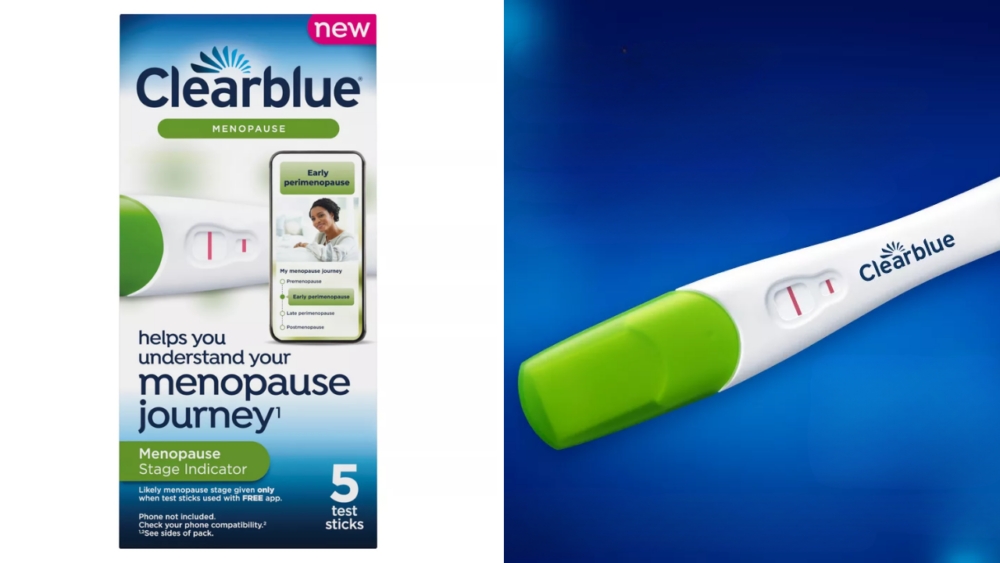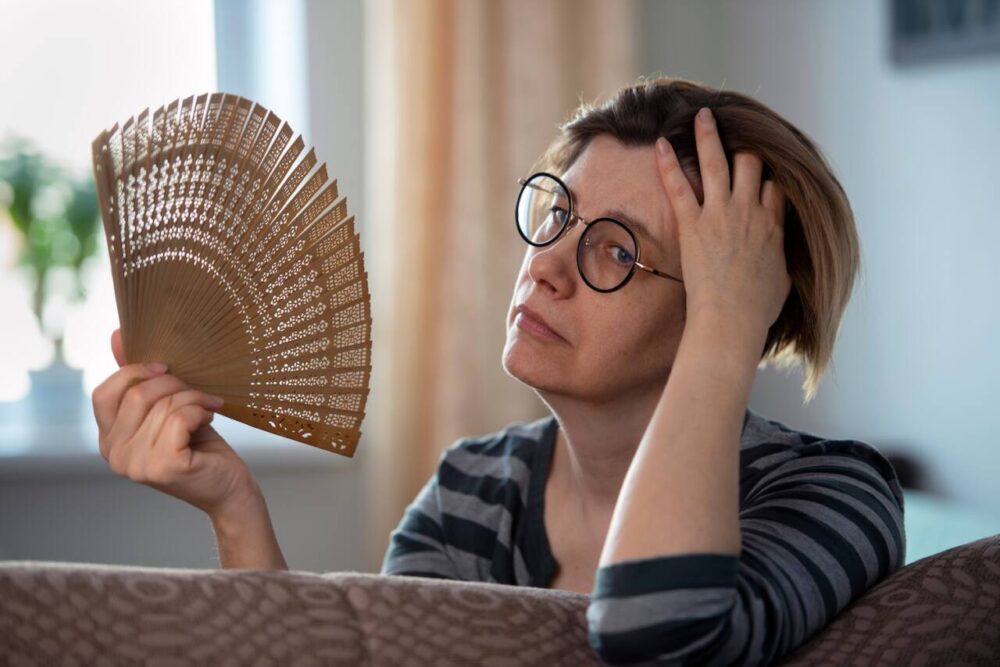The last time I considered buying a test stick to pee on was when I believed I was pregnant.
Cut to present day, and now I can say with nearly 100% conviction that at the newly minted age of 53 and with a husband who had a vasectomy 22 years ago, if I’m peeing on a stick, pregnancy is not the source of my suspicion.
But during a recent shopping trip, and through a number of ads I’ve seen scroll by on my social media feeds, I spotted at-home menopause kits. Just like a pregnancy test, a woman can buy a test kit, take the test at home — and the results are supposed to determine what stage of menopause she is experiencing.

At-home menopause tests, like the Clearblue Menopause Stage kit above, can be found at major retailers such as Walmart and Target for around $20.
I also found a perimenopause test available from Everlywell that requires a blood sample to be taken at home and sent in to a lab. This test costs $99. Femometer has a basic menopause kit with six urine strips for $14.
But, as I thought about buying one of these kits, a number of questions popped into my mind. What is involved with taking an at-home menopause test? What are at-home menopause tests measuring? Who are at-home menopause tests targeting? And finally, what do doctors think about them?
I decided to do some research about at-home menopause tests before making a decision to buy the kit and go through the process. After all, this is an important medical issue and needs to be treated seriously.
The At-Home Menopause Test Process
Unlike an at-home pregnancy test, which requires only one sample, the at-home menopause test needs to be repeated a total of five times over 10 days. The Clearblue at-home menopause test provides detailed instructions to complete all of the steps.
Testers need to scan a QR code on the package insert to download the free Menopause Stage – Clearblue Me app. Once registered on the app, testers receive daily updates on when to test and enter results.
The process is a matter of testing urine samples every other day and entering the results into the app after five minutes. Results will show up either as positive (one red line in the test window and one in the control window) or negative (only one red line in the control window).

But, what do these results mean? Positive for what?
What Does An At-Home Menopause Test Measure?
The test literature describes that the test measures the level of follicle-stimulating hormone (FSH) in a women’s body.
“FSH is produced by the pituitary gland and its levels tend rise as a women’s ovaries produce fewer eggs,” explained Dr. Darrell Martin, an obstetrician and gynecologist with over 40 years of experience and founder of Southern Crest Women’s Healthcare, in an email to me. “Elevated FSH levels can be an indication of menopause or perimenopause.”

As a woman ages, her ovaries stop producing eggs, and hormones like FSH, estrogen and progesterone begin to decline. When this transition begins, a woman enters perimenopause and this can last for years. During perimenopause, women can have the well-known symptoms associated with menopause, including night sweats and hot flashes, mood swings, insomnia, lower sex drive, itchy skin and more.
Who Is The Target For At-Home Menopause Testing?
Menopause is medically defined as when a woman’s menstruation stops for at least 12 months, according to all of the doctors I connected with via email, as well as the Cleveland Clinic and other health institutions.
The average age of diagnosed menopause for women is 51 years, according to the Cleveland Clinic. However, with perimenopause lasting years before menopause for many women, there are many potential customers for at-home menopause tests.
With so many physical and emotional side effects to perimenopause and menopause, and so few definitive answers on how long the process takes, an at-home test can be seen as a possible way to shine a light on what’s happening. There are also women, such as myself, who cannot use menstruation as a progress marker. I had a uterine ablation more than a 15 years ago due to heavy periods. As a result, I haven’t menstruated in years. So, beyond the typical symptoms leading up to menopause, how do I know if I’m closing in on the menopause finish line? Could the at-home test be the indicator?

What Do Doctors Think About At-Home Menopause Tests?
I reached out to a group of board-certified OB-GYNs for their opinion on the effectiveness and necessity of at-home menopause tests. The response was unanimous.
“At-home menopause tests are not something I would ever recommend,” replied OB-GYN Dr. Jen Gunter, author of the bestselling “The Menopause Manifesto.” “I cannot speak to their accuracy, as they have not published studies in peer-reviewed literature.”
Dr. Lauren Streicher, clinical professor of obstetrics and gynecology at Northwestern University’s School of Medicine and founding medical director of the Northwestern Medicine Center for Menopause, took this opinion even further, claiming these tests market to women’s discomfort and fear while experiencing perimenopausal and menopausal symptoms.
“The companies marketing these tests acknowledge that these levels can fluctuate and get around this problem by giving you five test kits to use over the course of 10 days,” she told me in an email. “However, 10 days out of a month isn’t long enough to get the big picture. The nature of perimenopause is that you may have normal estrogen levels for weeks, and then tank for a few months. In addition, the Clearblue FSH is not positive until it reaches 25. So, if your FSH is 20, you will be told you are not in perimenopause. And that is not necessarily the case.”
Dr. Alyssa Dweck, gynecologist and chief medical officer at Bonafide Health, agreed with Streicher’s assessment that FSH levels “wax and wane” during menstrual cycles and perimenopause. She advised against trying to obtain a specific diagnosis from an over-the-counter test.
“This is not a 100% diagnostic test, but truly meant to support what is already suspected clinically,” she replied via email. “There is no absolute diagnostic test for menopause.”

Should You Take an At-Home Menopause Test?
After all of this discussion, I opted not to take the test. While none of the doctors said it was dangerous to take it, and despite not having a menstrual cycle to use as a gauge, I determined my age and other symptoms were enough information for me to realize I’m either in the late stages of perimenopause or early menopause.
Further, as all of the doctors suggested, I plan to discuss my concerns with my doctor next month at my annual physical exam.
The doctors also all advised that anyone who has stopped menstruating before age 45 should first double-check for pregnancy before considering menopause as the cause.
If not pregnant, patients should consult their doctor about the lack of menstruation and any other symptoms. Only a licensed doctor can address a medical concern — including menopause.
Should you take an at-home menopause test? Here’s what doctors have to say originally appeared on Simplemost.com


